Chamomile soap harnesses this healing flower's anti-inflammatory and antimicrobial properties to soothe irritated skin, reduce redness, and prevent breakouts. You'll need to choose between Roman chamomile (relaxing aroma) or German chamomile (stronger skin healing). After harvesting and drying your flowers, combine them with quality oils, lye solution, and essential oils following proper safety protocols. Allow your soap to cure for 28 days for ideal therapeutic benefits. Discover how this ancient botanical can transform your skincare routine from ordinary to extraordinary.
Healing Chamomile Flower Soap: A Complete Guide
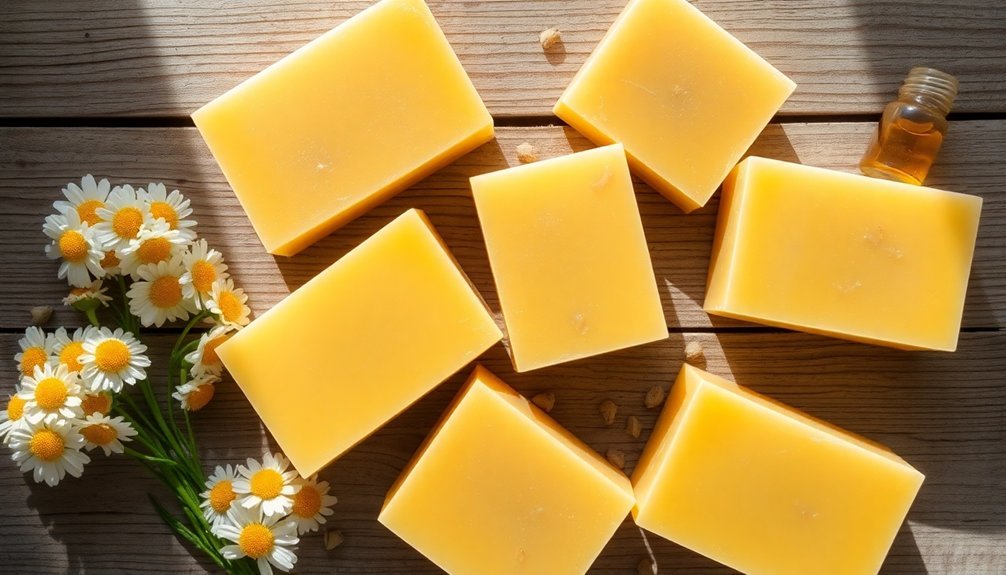
The gentle power of chamomile transforms ordinary soap into a therapeutic skin remedy. When you craft cold process soap using chamomile essential oil and dried flowers, you're creating a natural solution for sensitive skin and conditions like eczema.
By preparing a chamomile infusion for your lye solution, you'll enhance the soap's soothing benefits while achieving a creamy color.
The 28-day curing process guarantees your soap reaches a near-neutral pH, making it gentle enough for toddlers and adults alike.
The combination of olive oil, coconut oil, and shea butter delivers exceptional moisturizing qualities while supporting the anti-inflammatory properties of chamomile.
Your finished soap won't just cleanse—it'll calm irritated skin and provide lasting relief with a shelf life of up to two years.
The Therapeutic Benefits of Chamomile for Skin
While many natural ingredients claim skin benefits, chamomile stands apart as a powerhouse of therapeutic properties scientifically proven to transform your skincare routine.
This healing chamomile contains potent anti-inflammatory properties that effectively soothe irritated skin, reducing redness and providing relief for conditions like eczema and dermatitis.
You'll notice improved skin hydration as chamomile helps restore your skin's natural moisture barrier, making it ideal for dry, sensitive complexions.
Its antimicrobial properties combat acne-causing bacteria, preventing breakouts and infections that can damage your skin's appearance.
The antioxidants in chamomile, particularly apigenin, promote skin regeneration and collagen production, fighting aging signs while its calming scent reduces stress-related skin issues.
Incorporating chamomile soap into your daily routine offers gentle yet effective soothing skin care.
Roman vs. German Chamomile: Choosing the Right Variety
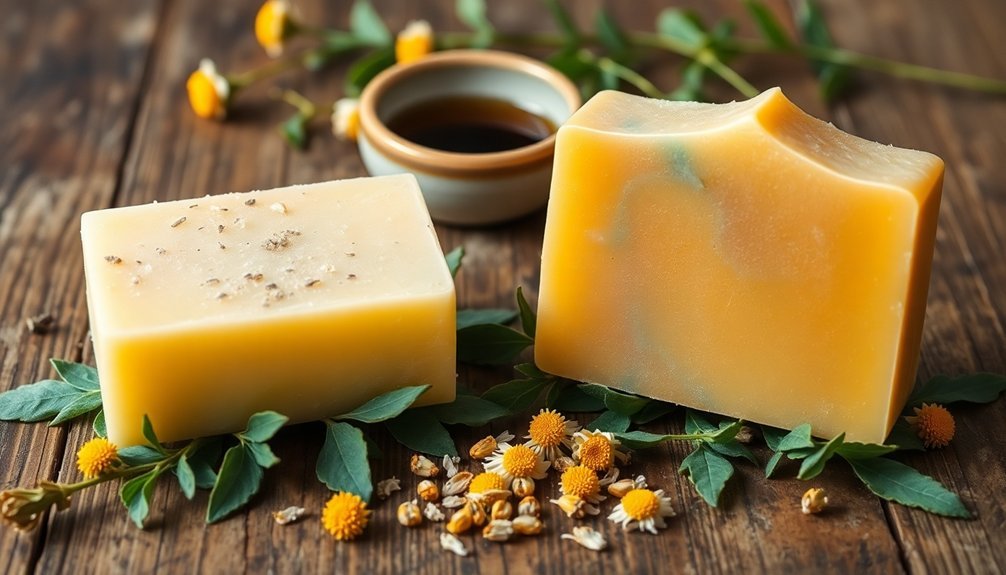
When crafting chamomile soap, you'll need to distinguish between Roman chamomile's low-growing, apple-scented flowers and German chamomile's taller stalks with daisy-like blooms.
Roman varieties excel in creating relaxing, aromatherapeutic soaps while German chamomile's blue oil delivers superior anti-inflammatory benefits for problem skin conditions.
Your processing method matters too—home-dried flowers preserve more therapeutic compounds than commercial alternatives, directly affecting your final soap's healing properties.
Visual Identification Differences
Two distinct varieties of chamomile create very different soaps, making visual identification essential for soap makers. When sourcing your ingredients, you'll need to distinguish between Roman chamomile and German chamomile by their appearance.
| Feature | Roman Chamomile | German Chamomile |
|---|---|---|
| Height | Low-lying perennial (6-12") | Taller annual (24-30") |
| Flowers | Compact, fewer petals | Larger, more pronounced |
| Color | White petals, yellow center | White petals with prominent yellow dome |
| Essential Oil | Light yellow, sweet aroma | Deeper blue, stronger scent |
Roman chamomile's compact structure yields a gentle oil perfect for sensitive skin care formulations. German chamomile stands taller with larger blooms, producing a distinctive blue essential oil ideal for therapeutic applications. Recognizing these visual differences guarantees you select the appropriate variety for your intended soap benefits.
Therapeutic Property Comparison
Beyond their visual differences, Roman and German chamomile offer distinct therapeutic benefits that will influence your soap-making decisions.
Roman chamomile's sweet, floral scent makes it perfect for relaxation-focused soaps, helping to reduce stress through aromatherapy.
If you're creating healing soaps for problematic skin conditions, German chamomile is your ideal choice. Its potent anti-inflammatory properties excel at treating eczema and skin irritations. This variety contains stronger therapeutic compounds that effectively soothe sore muscles and reduce inflammation.
For maximum potency in your soap, consider using home-dried chamomile rather than store-bought options.
Remember that Roman chamomile's perennial nature provides year-round availability, while German chamomile's annual growth cycle might affect your production schedule.
Choose based on your soap's intended skin benefits and therapeutic goals.
Processing Impact Assessment
Both varieties of chamomile respond differently to processing methods, which greatly affects their effectiveness in your finished soap.
When crafting handmade soap, consider that home-dried chamomile flowers maintain superior potency compared to commercial alternatives. German chamomile's essential oil, with its higher chamazulene content, produces a vibrant blue color and retains more anti-inflammatory properties even through saponification, making it ideal for natural soap recipes targeting skin complaints like eczema.
Roman chamomile, however, preserves its calming aromatic qualities better during the soap-making process. The heat from saponification impacts Roman's sweet, floral notes less severely than German's medicinal properties.
For maximum therapeutic benefit, consider adding either essential oil at cooler temperatures during trace rather than incorporating it earlier when temperatures are higher, ensuring your chamomile soap delivers its intended healing properties.
Harvesting and Drying Chamomile Flowers for Soap Making
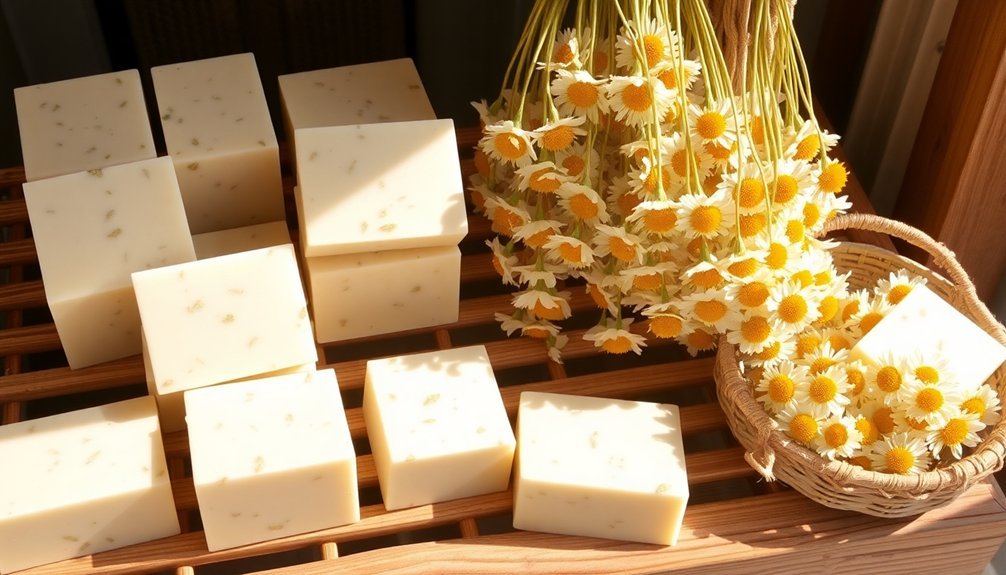
The secret to creating exceptional chamomile soap lies in properly harvested and dried flowers. For peak potency, harvest your chamomile during summer when the flowers are fully bloomed, choosing dry weather to pick the flower heads.
To dry your chamomile flowers, spread them in a single layer on a clean surface or hang small bundles in a well-ventilated area away from direct sunlight. The drying process typically takes one to two weeks. You'll know they're ready when they feel completely dry to the touch—any remaining moisture can cause mold.
Store your dried flowers in airtight containers in a cool, dark place. Home-dried chamomile is superior for soap making because it retains more essential oils and fresh properties than store-bought alternatives, enhancing your soap's therapeutic qualities for up to a year.
Essential Tools and Ingredients for Chamomile Soap
Creating luxurious chamomile soap requires specific tools and ingredients to guarantee success and safety throughout the process.
You'll need essential tools including safety glasses, rubber gloves, a kitchen scale for precise measurements, a heat-resistant pitcher, and soap molds.
For ingredients, gather 15 oz coconut oil, 15 oz olive oil, 12 oz almond oil, 6 oz shea butter, and 1.5 oz castor oil. The lye solution requires 15 oz distilled water and 7.2 oz sodium hydroxide. Measure all oils by weight for accuracy.
Dried chamomile flowers serve as both decoration and therapeutic elements, while chamomile essential oil should be used sparingly to prevent irritation.
For added benefits, prepare a chamomile infusion by steeping dried flowers in hot water. Always prepare all ingredients before starting your soap-making process.
Creating a Chamomile Tea Infusion for Your Lye Solution
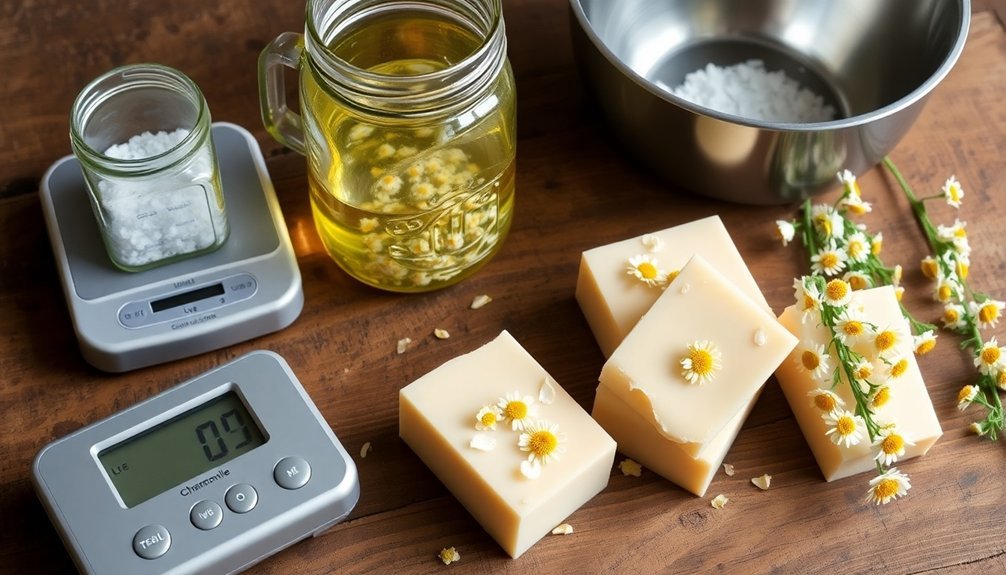
Infusing your lye solution with chamomile tea elevates your handmade soap from ordinary to exceptional by transferring the flower's soothing properties directly into your formula.
To create this beneficial infusion, steep dried chamomile flowers in boiling distilled water at a 1:4 ratio for 15-20 minutes.
Once your chamomile tea has cooled to room temperature, strain out all flower particles to obtain a clear liquid.
When mixing with sodium hydroxide, always add the lye to the cooled tea—never reverse this order—to prevent dangerous reactions.
Allow your chamomile tea lye solution to cool to approximately 100°F before combining it with your oils.
This temperature guarantees you'll achieve the perfect trace consistency during the soap-making process, while preserving the therapeutic qualities of the chamomile infusion.
Cold Process Method for Chamomile Soap
Safety should be your priority when working with lye, requiring protective gloves, goggles, and proper ventilation throughout the soapmaking process.
You'll know you've reached "trace" when your soap mixture leaves a visible trail on the surface, looking similar to pudding consistency.
Once you've achieved trace, work quickly to add your chamomile essential oil and pour the mixture into molds before it hardens.
Lye Safety Essentials
When working with lye in your chamomile soap-making process, your diligence about safety precautions can't be overstated.
Always wear safety goggles and rubber gloves when handling lye to protect yourself from severe burns that can occur upon skin or eye contact with this caustic substance.
Mix your lye solution in a well-ventilated area, preferably outdoors or near an open window, to avoid inhaling harmful fumes.
Remember the critical rule: always add lye to water, never water to lye, to prevent dangerous splashing from the exothermic reaction.
Use a heat-resistant pitcher for mixing lye with your chamomile tea, guaranteeing it's completely dissolved before combining with oils.
Allow the solution to cool to approximately 100°F before proceeding to guarantee proper saponification without overheating.
Achieving Perfect Trace
The perfect trace marks the heartbeat of cold process soap making, transforming your chamomile soap mixture from separate components into a unified creation. After pouring the lye solution into your oils at 100°F (38°C), use your immersion blender in short bursts, then stir manually to monitor consistency.
| Trace Stage | Appearance | Best For |
|---|---|---|
| Light | Thin, leaves faint trail | Swirl designs |
| Medium | Pudding-like consistency | Basic designs |
| Heavy | Holds its shape well | Textured tops |
| Accelerated | Thickens rapidly | Quick pours |
| False | Temporary thickening | Wait before panic |
Once you've achieved trace, quickly add your chamomile essential oil while the soap mixture is still workable. Don't delay in transferring to molds—the mixture continues thickening even after you've stopped blending.
Hot Process Technique With Chamomile Flowers
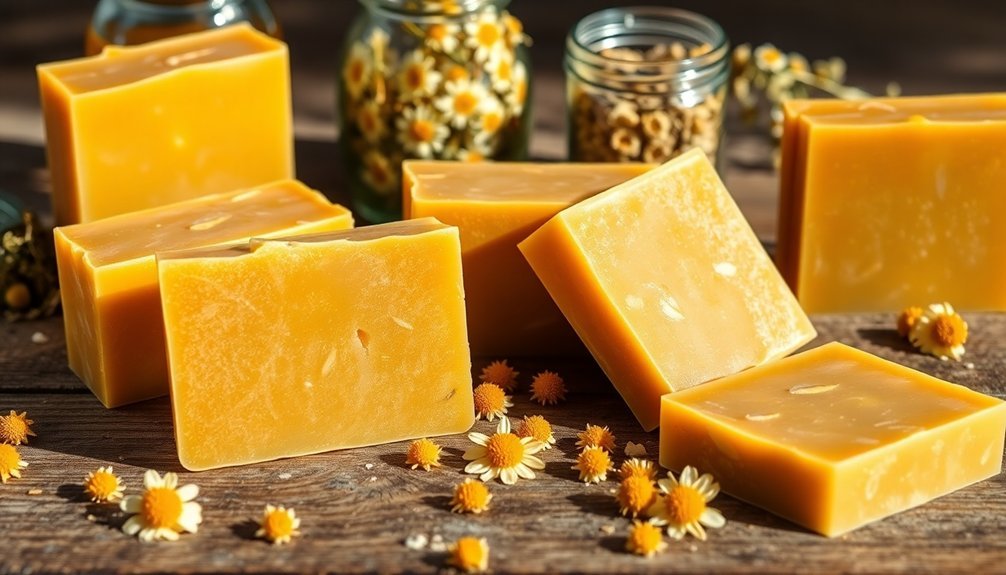
Three key advantages make hot process soap-making particularly suitable for chamomile flower soap.
First, the accelerated saponification in your crockpot means you'll enjoy your soap within days rather than weeks.
Second, adding chamomile essential oil after cooking preserves its therapeutic properties and delicate fragrance that high temperatures would otherwise diminish.
Third, you maintain more control over the final appearance when incorporating dried chamomile flowers.
Begin by melting your solid oils, then add your chamomile tea-based lye solution.
Cook until the mixture resembles thick mashed potatoes.
Once it passes the "zap test," stir in your essential oil and dried chamomile flowers.
Pour quickly into your soap mold while still hot, insulate it, and let it set.
Unlike cold process, you'll have usable soap in just days!
Adding Chamomile Essential Oil at Trace
When adding chamomile essential oil at trace, select high-quality organic varieties to maximize therapeutic benefits in your final soap.
You'll need approximately one-third the amount compared to other essential oils—measure carefully to avoid overpowering the delicate floral notes while maintaining skin compatibility.
Wait until your soap mixture reaches the perfect trace consistency before gently stirring in the essential oil to preserve its soothing properties throughout the saponification process.
Essential Oil Selection Tips
Why does timing matter so much when working with chamomile essential oil in soap making? Adding chamomile at the right moment—when your mixture reaches a consistent trace—ensures even distribution and preserves its therapeutic properties. You'll need to work quickly, as heat exposure can diminish chamomile's inflammation-reducing benefits for sensitive skin.
| Essential Oil Pairing | Benefits | Ratio with Chamomile |
|---|---|---|
| Lavender | Enhances calming effect | 2:1 (lavender:chamomile) |
| Sweet Orange | Brightens fragrance | 2:1 (orange:chamomile) |
| Alone | Pure chamomile experience | Use 1/3 amount of normal EO |
Measuring Without Mistakes
Although many soapmakers rush this crucial step, precise measurement of chamomile essential oil determines your soap's success. When working with chamomile, you'll need only 1/3 the amount compared to other essential oils to achieve a balanced fragrance profile.
Once your soap mixture reaches trace—that distinctive thickness where drizzled soap leaves a visible trail on the surface—it's time to act. Use a digital scale for accuracy, as even small measurement errors can affect your final product.
Add the chamomile essential oil quickly after reaching trace, then stir gently to prevent air bubbles from forming.
Don't delay once you've hit trace; the mixture thickens rapidly, making it harder to incorporate the oil evenly. This precision guarantees your chamomile soap delivers both the perfect scent and therapeutic benefits.
Perfect Timing Techniques
The art of adding chamomile essential oil perfectly complements our measurement guidelines.
You'll want to add it only after your soap mixture reaches "trace," the point where oils and lye have properly emulsified.
Wait until your soap mixture cools to approximately 100°F before incorporating any essential oils. For chamomile specifically, use just 1/3 the amount of other essential oils in your recipe to create a balanced fragrance while maximizing its therapeutic benefits.
Once at trace, blend the chamomile essential oil quickly but gently—avoid over-mixing which can thicken your soap prematurely before pouring.
This careful timing not only preserves the delicate aroma but also guarantees the skin-soothing properties of chamomile remain intact, making your final product especially beneficial for sensitive skin.
Decorative Techniques With Dried Chamomile Flowers
Artistry with dried chamomile flowers transforms ordinary soap into visually stunning creations. For the best results, add these botanical elements while your soap is still liquid in the mold. They'll adhere properly without sinking, creating that perfect decorative finish.
You'll achieve greater visual interest by combining whole and crushed dried chamomile flowers on your soap's surface. Once your mixture reaches trace consistency, gently press the flowers into the thickening soap to create appealing texture without compromising integrity.
Don't overdo your decorations—excessive flowers can create drag marks during cutting. For the freshest look and maximum benefits, use home-dried chamomile flowers rather than store-bought options.
They'll retain more essential oils and vibrant colors, enhancing both the aesthetic appeal and therapeutic properties of your finished soap bars.
Proper Curing and Storage of Chamomile Soap
Crafting perfect chamomile soap requires patience during the essential curing phase. After pouring your mixture into molds, allow it to harden for 2-3 days before carefully unmolding.
Then comes the vital step—cure your soap bars for a full 28 days in a cool, dry space away from direct sunlight.
During this 4-week cure, you'll notice your soap developing its signature chamomile fragrance as excess moisture evaporates, enhancing both quality and longevity.
Once fully cured, store your bars in a well-ventilated area wrapped in breathable materials that protect against moisture while preserving their delightful scent.
With proper storage, your chamomile soap will maintain its beneficial properties for up to two years—ensuring you'll enjoy its soothing qualities long after creation.
Frequently Asked Questions
What Is Chamomile Soap Good For?
Chamomile soap is good for your sensitive skin, eczema, and dermatitis. It'll soothe irritation, promote skin regeneration, protect against environmental damage, and moisturize effectively. It's also gentle enough for toddlers over 12 months.
What Essential Oils Should Not Be Used in Soap?
You should avoid using cinnamon, clove, oregano, thyme, lemongrass, wintergreen, birch, eucalyptus, and peppermint oils in soap. They can cause skin irritation, phototoxicity, or toxic reactions in sensitive individuals.
How to Put Chamomile in Soap?
You'll add chamomile to soap three ways: mix in dried flowers (½ cup), use flower-infused water for your lye solution, and incorporate chamomile essential oil at trace using 1/3 the normal amount.
What Is Chamomile Tincture Good For?
Chamomile tincture helps you reduce skin inflammation, ease anxiety, improve sleep, soothe digestive issues, and boost your immune system. You'll find it works well both topically for skin conditions and internally for relaxation.
In Summary
You've now mastered the art of making chamomile flower soap! With your new skills, you'll create gentle, skin-soothing bars that harness chamomile's anti-inflammatory powers. Remember to properly cure your soaps for best results, and don't be afraid to experiment with different techniques. Your homemade chamomile soaps make wonderful gifts or a luxurious addition to your self-care routine.

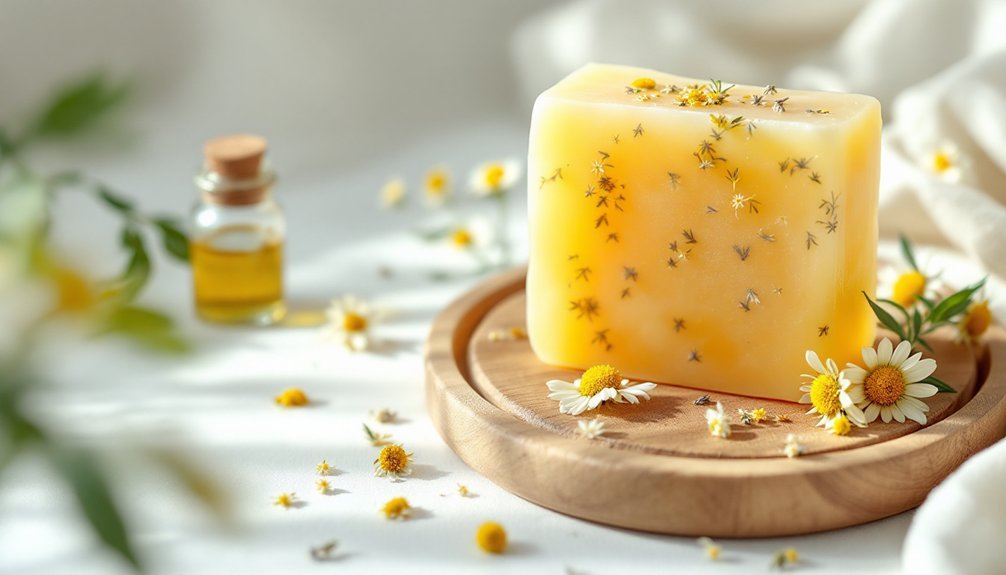



Leave a Reply